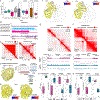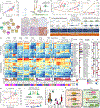Glioblastoma evolution and heterogeneity from a 3D whole-tumor perspective
- PMID: 38242087
- PMCID: PMC10832360
- DOI: 10.1016/j.cell.2023.12.013
Glioblastoma evolution and heterogeneity from a 3D whole-tumor perspective
Abstract
Treatment failure for the lethal brain tumor glioblastoma (GBM) is attributed to intratumoral heterogeneity and tumor evolution. We utilized 3D neuronavigation during surgical resection to acquire samples representing the whole tumor mapped by 3D spatial coordinates. Integrative tissue and single-cell analysis revealed sources of genomic, epigenomic, and microenvironmental intratumoral heterogeneity and their spatial patterning. By distinguishing tumor-wide molecular features from those with regional specificity, we inferred GBM evolutionary trajectories from neurodevelopmental lineage origins and initiating events such as chromothripsis to emergence of genetic subclones and spatially restricted activation of differential tumor and microenvironmental programs in the core, periphery, and contrast-enhancing regions. Our work depicts GBM evolution and heterogeneity from a 3D whole-tumor perspective, highlights potential therapeutic targets that might circumvent heterogeneity-related failures, and establishes an interactive platform enabling 360° visualization and analysis of 3D spatial patterns for user-selected genes, programs, and other features across whole GBM tumors.
Keywords: brain tumors; chromatin accessibility; chromatin interactions; epigenomics; genomics; glioblastoma; intratumoral heterogeneity; microenvironment; spatial analysis; tumor evolution.
Copyright © 2023. Published by Elsevier Inc.
Conflict of interest statement
Declaration of interests The authors declare no competing interests.
Figures







Comment in
-
A holistic view of the malignant organism we call glioblastoma.Cell. 2024 Jan 18;187(2):271-273. doi: 10.1016/j.cell.2023.12.021. Cell. 2024. PMID: 38242083
References
-
- Nicholson JG, and Fine HA (2021). Diffuse Glioma Heterogeneity and Its Therapeutic Implications. Cancer Discov. 11, 575–590. 10.1158/2159-8290.CD-20-1474. - DOI - PubMed
-
- Ceccarelli M, Barthel FP, Malta TM, Sabedot TS, Salama SR, Murray BA, Morozova O, Newton Y, Radenbaugh A, Pagnotta SM, et al. (2016). Molecular Profiling Reveals Biologically Discrete Subsets and Pathways of Progression in Diffuse Glioma. Cell 164, 550–563. 10.1016/j.cell.2015.12.028. - DOI - PMC - PubMed
Publication types
MeSH terms
Grants and funding
- R01 HG011207/HG/NHGRI NIH HHS/United States
- R01 HG009906/HG/NHGRI NIH HHS/United States
- R01 CA244621/CA/NCI NIH HHS/United States
- T32 CA151022/CA/NCI NIH HHS/United States
- R01 MH123156/MH/NIMH NIH HHS/United States
- R01 MH113896/MH/NIMH NIH HHS/United States
- P50 CA097257/CA/NCI NIH HHS/United States
- F32 CA239472/CA/NCI NIH HHS/United States
- R35 GM124820/GM/NIGMS NIH HHS/United States
- U01 CA229345/CA/NCI NIH HHS/United States
- R35 NS105068/NS/NINDS NIH HHS/United States
- P01 CA118816/CA/NCI NIH HHS/United States
- R01 CA169316/CA/NCI NIH HHS/United States
- R50 CA274229/CA/NCI NIH HHS/United States

